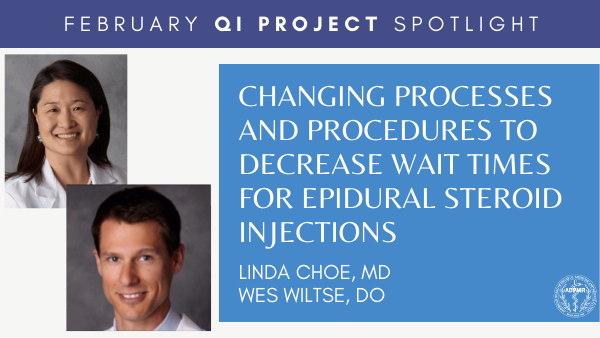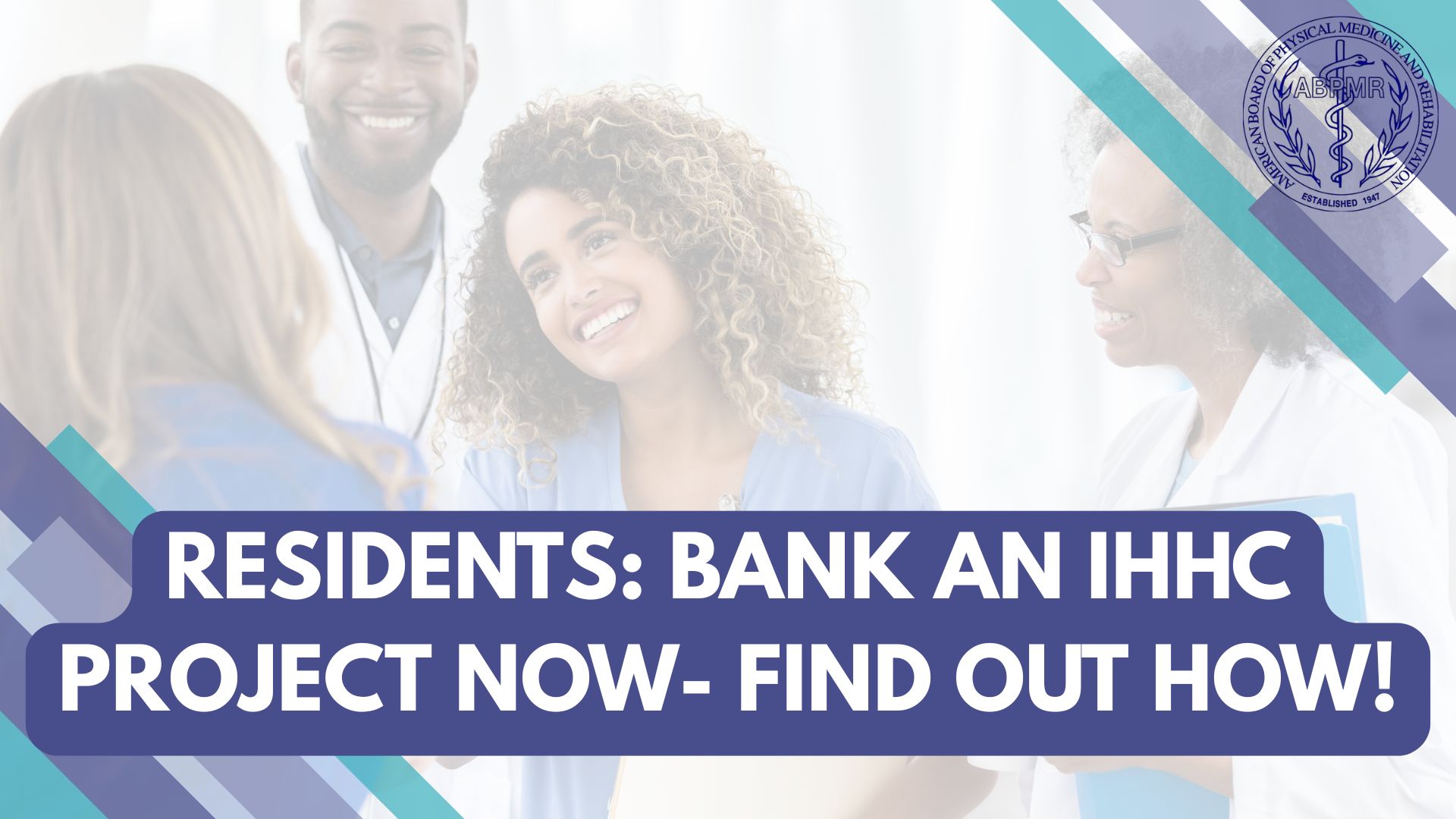CC
QI Spotlight: Changing Processes and Procedures to Decrease Wait Times for Epidural Steroid Injections

The February QI project feature was submitted by Linda Choe, MD, and Wes Wiltse, DO.
Their project focused on improving efficiency and decreasing wait times for epidural steroid injections in their interventional PM&R spine clinic. By making small changes in processes, procedures, and communication, Drs. Choe and Wiltse met their goal of decreasing wait times from six weeks to less than four weeks.
Thank you for submitting your project, Dr. Choe and Dr. Wiltse!
The QI Project Spotlight is a periodic feature on the ABPMR News Center to highlight exemplary Quality Improvement projects submitted by your fellow diplomates (or residents) for continuing certification (CC) credit. Diplomates can use the QI Project Spotlight as a tool to plan their own QIs or as a way to connect with other diplomates doing similar work.

What is the problem you are trying to solve?
In our high volume interventional PM&R spine clinic, the wait time for injections/procedures has been increasing over time to the point of a nearly six-week waiting time for epidural steroid injections. This has led to the need for referring to other facilities, prolonged patient discomfort, increased time to definitive care/outcomes, a delay in providing optimal rehabilitation process (ie, physical therapy) to those individuals in whom the pain precluded active participation, and the need to double book procedures in an effort to reduce wait times. We seek to improve efficiency by implementing smaller and actionable changes in scheduling, team workflow, and clinic/procedure space efficiency to result in a global improvement in access to procedures with improved wait times to less than four weeks consistently.
What data (objective measurements) do you have that supports this as a problem?
Our data was measured using a metric within our local institution known as “Initiated to Seen” (ITS). This value is the exact number of days from the time the referral/order for the procedure was placed to the date the procedure was completed. During the period of January 2019 through August 2019, the average ITS was five weeks with some as long as eight weeks, and only those who were double-booked had wait times of less than two weeks.
What is your opportunity statement? State the goal you hope to achieve.
We anticipate that with multiple, small changes in all aspects of the workflow— from scheduling to completing procedures— we can improve wait times from six weeks to less than four weeks consistently.
What is the underlying cause of the performance/quality problem?
As membership in the medical group has grown, the number of referrals to the PM&R Spine Clinic has also grown. We have not, however, increased number of interventional physiatrists to help absorb this demand, nor have we increased the number of available procedure slots in any given month. Additionally, we have not made any changes to the number of procedures performed on a given procedure day. While our interventionalists are capable of performing more procedures safely, there has been significant concern in doing so within the constraints of this particular clinic due to inefficiencies of space/workflows.

What change(s) did you implement?
-
Physiatrist-led meeting was held with department chiefs, managers, and medical assistants to discuss the need for changes and ideas for how to achieve this
-
Primary goal of adding an additional two procedures per procedure day was proposed
-
Ideas focused on specific strategies to achieve additional procedures were discussed and tests of change were implemented. Specifically, these changes were:
-
Changing procedure profile from 35 min per procedure to 30 min per procedure
-
Patients arrive 30 min before scheduled procedure to allow for completion of intake paperwork (questionnaire, driver form, and to read the consent form)
-
Any late arrivals would be replaced by an early-arrived patient, if applicable (to decrease need for staff-imposed cancellations)
-
Coordinated with reception staff managers to teach receptionists how to release fluoroscopy orders (to reduce this step for radiology technologists)
-
Coordinated with radiology technology managers to ensure consistent staffing from a cohort of proven efficient C-arm operators
-
“Walkie-talkie” radios purchased for communication between radiology technologist and medical assistants to notify the latter when procedure completed. This would allow for improved decision-making by the medical assistant whether to room next patient or to return to the procedure suite to begin turning over the room.
-
A privacy divider would be installed between procedure suite and recovery area to allow for medical assistant to escort next patient into the suite while physician discharges previous patient, all without violating HIPAA
-
Discussed new expectations with radiology technologists during procedures:
a.) Assist medical assistant with transferring patient on/off procedure table
b.) Assist physician with passing injectable meds (ie, holding vial while physician draws)
c.) If medical assistant rooming a patient at conclusion of procedure, radiology technologist will assume role of medical assistant for cleaning and transferring patient until medical assistant returns
d.) After physician performs post-procedure assessment, radiology technologist will escort patient to the waiting room where they will find their driver

Did you achieve your goal or target from your opportunity statement? What data do you have to support your conclusion?
Yes. Starting in April 2019, we were able to increase our volume from 11 procedures per day to 13 or 14 procedures per day, without ever dropping below 13. At the outset of April 2019, the average ITS was five weeks. By the end of April 2019, this ITS average dropped to 4.5 weeks. By the end of May 2019, the average ITS was still 4.5 weeks. There was further improvement by the end of June at four weeks average ITS. By the end of July 2019, this had dropped further to 3.5 weeks. By the end of August 2019 our average ITS was three weeks. Although formal data was not collected thereafter, our medical assistants reported significant decline in patient calls inquiring about the status of the scheduling or comments about the “long wait.” Physicians reported increased ease of scheduling more urgent procedures within one to two weeks consistently.

Will you continue with the changes you have implemented?
These changes had become a permanent part of our practice and continued until shelter-in-place orders were enacted due to the COVID-19 pandemic resulting in temporary cessation of elective procedures in mid-March 2020 through the end of April. We have recently begun resuming procedures and continue to implement these strategies to ensure safety and efficiency.
The success of this project undoubtedly began in the pre-planning stages during which everyone was encouraged to provide input and suggestions. Consistently engaging all participants as to the “why” and “how” of the process, furthermore, engendered ownership of the process and fostered success after implementation.

